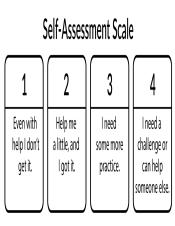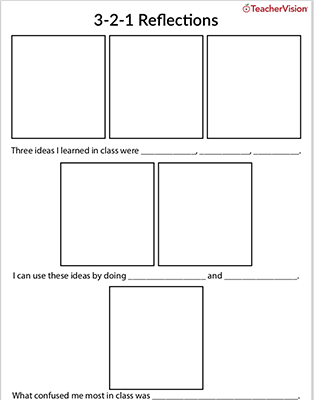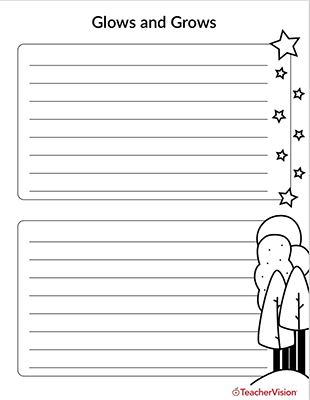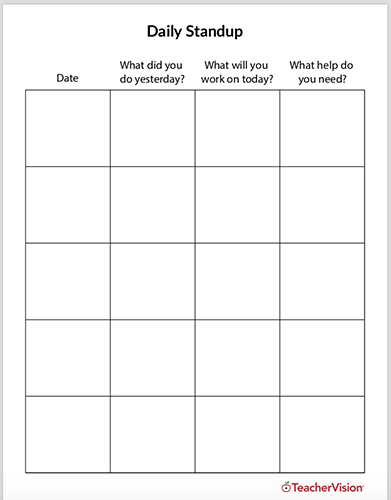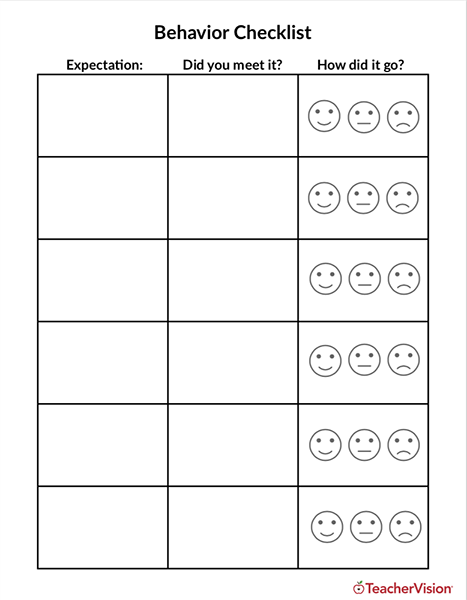The strategies in this playlist represent different teaching moves that you can incorporate into your existing instructional routines and procedures. Each strategy is designed to support students with an opportunity to reflect on their learning, and by doing so, build self-awareness and determine their next step and take ownership over their work.
Strategy Name: Self-Assessment Scale |
|
| Providing students with a set of criteria for assessing their learning builds self-awareness and encourages reflection. | |
|
|
What Is It?A self-assessment scale is a set of criteria that students use to reflect on their level of understanding at the end of a lesson. Students become more self-aware as a result of using this criteria, and that awareness supports them to take ownership over their learning and identify their next steps. After using the self-assessment scale, students are able to articulate if they are lost and need more instruction, if they need additional practice or if they feel confident that they have mastered the material. Why Is It Important?Research shows that when students are provided with consistent opportunities to engage in self-assessment strategies they are more likely to believe that they can impact their own learning, and they are less likely to attribute their academic success to luck or unknown variables (British Journal of Education Psychology). When teachers take ownership over their learning, and develop self-awareness, they can use that knowledge and understanding in order to take action. If a student finishes a lesson and doesn’t stop and think about how it went, and how well he understood the material, then the student is less likely to initiate the actions necessary to master that material. Self-assessment strategies provide a framework that students can use to better understand their learning. How Can You Make It Happen?Consider incorporating a self-assessment scale into your classroom routines and procedures. The more practice and exposure that your students have to the self-assessment scale, the more intuitive the process will become. Many teachers use this strategy after they teach new material because it helps them identify their next steps, whether those are reteaching, providing additional practice or supporting students with modifications or extensions. When Can You Use It?This strategy works best when you are teaching your students new material and they have had some practice. Students’ responses to help you identify if you need to re-teach, provide students with additional practice, or if your students feel confident about the material and are ready to move on. The scale is meant to be used frequently during a teaching unit so students are able to see what parts of the material they need more practice with and what parts of the material they feel most confident about. Many teachers adopt the self-assessment scale as a daily practice of consistent routine and procedure that students come to expect as part of their learning process. How Can You Manage It?Many students may not be used to self-assessing their learning. They might look to you to tell them what criteria to select and to identify their next steps. When you introduce the criteria, model the process for students and make your thinking visible using an example from your own learning. Strive to create a classroom culture where students feel safe and comfortable honestly identifying if they need help or if they felt like the lesson was unclear. When students begin to recognize that learning is a process that includes confusion, hard work, and failure at times, they will feel more comfortable self-assessing honestly. To make the criteria more approachable, consider engaging in a whole class discussion where you unpack what a student may feel like or student like at each level. Some teachers find it helpful to create several scenarios and then ask the students to work together in small groups or as a whole class to determine what criteria best fits that scenario. This works well because the students begin using the criteria in low-stakes hypothetical situations, and then there is a gradual release to using it themselves. How Can You Stretch Students’ Thinking?Consider involving students in the process of crafting the criteria rather than determining the criteria and giving it to them directly. Students feel more ownership over the self-assessment process when they are involved from the beginning. This works especially well with older students, but can be equally successful in upper elementary classrooms. How Can You Modify And Support Students?For students who are having difficulty selecting criteria independently, it can be helpful to provide them with a word bank of phrases that relate to the particular lesson that was taught. This helps them identify specifically what aspect of the lesson they need more help with or they felt successful with. See the example below. |
Strategy Name: 3-2-1 Reflection |
|
| Providing students with a framework for reflection helps them organize their thoughts and synthesize their learnings. | |
|
|
What Is It?The 3-2-1 Reflection is a framework your students can use to reflect on their learning, synthesize their learning, and also identify which part of the material was confusing or they want to circle back to. This framework can be modified in a variety of ways depending on what information you hope to gather from students and what components you’d like them to reflect on. Why Is It Important?Research shows that when students are provided with consistent opportunities to engage in self-assessment strategies they are more likely to believe that they can impact their own learning, and they are less likely to attribute their academic success to luck or unknown variables (British Journal of Education Psychology). When teachers take ownership over their learning, and develop self-awareness, they can use that knowledge and understanding in order to take action. If a student finishes a lesson and doesn’t stop and think about how it went, and how well he understood the material, then the student is less likely to initiate the actions necessary to master that material. Self-assessment strategies provide a framework that students can use to better understand their learning. How Can You Make It Happen?If Exit Tickets are part of your classroom routines and procedures, consider integrating the 3-2-1 framework into the Exit Ticket. As part of your planning, identify what lessons lend themselves to providing students with an opportunity to use this framework. You can also consider assigning the framework as homework and beginning your next class by asking students to turn and talk to their elbow partner and share their reflection or ask students to volunteer and engage in a whole class reflection. When Can You Use It?Because the 3-2-1 is a reflection framework, it is most useful at the end of a unit, project, lesson or class. It is designed to support students to both synthesize their learnings, and consider questions that they have and want to follow up on. Like many other reflection protocols, students take ownership over their learning and understand what next steps they need to take in order to get their question answered. How Can You Manage It?Set clear expectations for your students around how much time they will have to complete their reflection, and what your goal is for their written output. How Can You Stretch Students’ Thinking?Challenge students to come up with their own 3-2-1 reflection frames. This can work especially well when students are working in small groups or on a project. Come up with different versions yourself so that students don’t repeat the same responses, but are challenged to reflect in different ways. How Can You Modify And Support Students?Consider providing students with sentence starters to scaffold the 3-2-1 reflection process. You may found that some of your students have trouble starting. Sentence starters will provide them with a starting point and get them writing. Here are some examples: Three ideas I learned in class were_______. I can use these ideas by doing ___________ and ____________. What confused me most in class was __________. |
Strategy Name: Glows and Grows |
|
| a framework for both reflection and feedback that supports celebration of success and recognition or areas for improvement. | |
|
|
What Is It?Glows and Grows is a framework to support students to both reflect, and also provide meaningful and actionable feedback. Students can give themselves glows and grows, and they can also give each other glows and grows. Why Is It Important?Learning how to give and receive constructive feedback is an important 21st Century skill. Students often aren't sure how to make their feedback actionable or what steps to take after they have received feedback. This provides them with a framework that makes the process more transparent. How Can You Make It Happen?Is there are particular project coming up where students could use Glows and Grows to provide each other with feedback? Do you have a unit where you want students to both give and receive feedback? Look at your curriculum map and upcoming plans and identify the best time to try this strategy. After you have tried it once, you will have a better sense of how it went, and what scaffolds you might need to put in place to continue using it more consistently. Don’t forget to ask your students for feedback so you can refine the strategy and make it work best for you and for them. When Can You Use It?Glows and Grows works especially well at the end of a learning experience, especially a project or unit that students have spent a lot of time on. Many teachers use it for peer editing to support students to give each other meaningful feedback about their writing, and also identify goals for their work moving forward. Others use it for grading and comments and will consistently provide Glow and Grows feedback for their students as both a formative and summative assessment. How Can You Manage It?Provide students with exemplars. Have a conversation with your class about which completed Glows and Grows show meaningful reflection. This conversation will make your expectations for this process clear and it will also provide concrete examples for your students, which will help them if they have difficulty getting started or they get stuck. Consider posting the exemplars on your LMS or on your classroom walls so you can direct students to them when they need help or get off task. To make the criteria more approachable, consider engaging in a whole class discussion where you unpack what a student may feel like or student like at each level. Some teachers find it helpful to create several scenarios and then ask the students to work together in small groups or as a whole class to determine what criteria best fits that scenario. This works well because the students begin using the criteria in low-stakes hypothetical situations, and then there is a gradual release to using it themselves. How Can You Stretch Students’ Thinking?Provide an extension for students, and encourage them to follow up their Glow and Grow process with goal setting. You can check out this SMART Goal worksheet to support your students to make their reflection actionable. How Can You Modify And Support Students?Consider sitting with a small group of students and guiding them through this process. You can ask clarifying questions, and build on their ideas. You can also conference with individual students or small groups and help them be more specific and further develop their Glows and Grows. |
Strategy Name: Daily Standup |
|
| Support students to take initiative by identifying what they did yesterday, what they will do today, and what help they need to be successful. | |
|
|
What Is It?The Daily Standup is a process that many businesses use in order to support employees to be successful as they work to complete a project. This strategy can also apply to your classroom. If you are working on a project and students have both short and long term deadlines, engaging them in a daily standup can keep them organized and on track. You can have students stand up and answer the three questions or you can also consider having students write them down. Either way, in order to answer the questions students need to be accountable and self-directed. Why Is It Important?Once they start working, students will not have a boss who is necessarily telling them what to do or asking them if they need help. It is important for students to learn how to ask for help, how to meet deadlines, and how to understand what they are accountable for. How Can You Make It Happen?Consider providing students with a graphic organizer that has the three questions and space to write their answers. You may want to also create an anchor chart in your classroom so that students can easily access the questions if students are going to share orally in class. When Can You Use It?This strategy works well when students are working on projects, but it can also be used as a daily reflection practice that students complete when they first enter your classroom. How Can You Manage It?Model the process for your students, and consider setting word length or time requirements so this process doesn’t take too much time. It is meant to be a quick way for everyone to check in, share their status and ask for help if they need it. If you have students write it down, consider collecting their organizers and writing back to them. You can provide positive encouragement, and also suggest how they can get the help that they need to be successful. How Can You Stretch Students’ Thinking?Consider putting students in charge of facilitating the process. This works especially well with older students. You could compile a schedule identifying which student is in charge which week. Ask students to take initiative and help other students if they are able to do so. How Can You Modify And Support Students?Model this process for your students, especially when you first start this process. Considering starting with one question and then adding another until you work your way up to all three. |
Strategy Name: Checklists |
|
| Support your students to hold themselves accountable for their work and behavior in class by providing them with a checklist. | |
|
|
What Is It?Academic, work habits, and behavior checklists make your expectations clear to students and provide them with the opportunity to take ownership over their work. Why Is It Important?In order for students to become more independent, we need to give them the tools to be successful, but also provide them with opportunities to be accountable for those expectations. We are also teaching students a valuable skill, which is organizing and prioritizing your responsibilities so you meet deadlines. How Can You Make It Happen?Decide what type of checklist you’d like your students to use. Do you want to provide them with a list of academic assignments? Do you want to provide them with a list of behaviors or actions? Create the checklist and have students place it on their desk or in their academic planner. When Can You Use It?You can use checklists during class projects, for the assignments in a unit, for class or individual goals. The possibilities are endless. How Can You Manage It?It is very important that you collect students checklists and provide them feedback. They will not take the assignment seriously if they aren’t held accountable for it. How Can You Stretch Students’ Thinking?Encourage students to come up with their own checklists rather than providing the checklist for them. This challenges students to determine what their do to list is, and how to prioritize what they tackle first. How Can You Modify And Support Students?Start with shorter checklists so that you don’t overwhelm students and they experience success with the process. Include due dates and other important information on the checklist, and help your students determine how to prioritize their list of tasks. |

